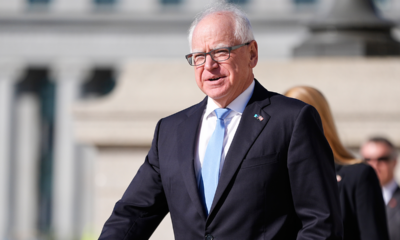North Dakota
Letter: Black-owned businesses are making history in North Dakota and across America

North Dakota small business owners are some of the strongest, most creative, and resilient people you will ever meet. In recent years, our small business community has weathered a global pandemic, persistent supply chain issues, sometimes volatile prices, and a tight labor market. Black-owned businesses in our state have faced disproportionate impacts from these pandemic challenges. Despite those headwinds, Black entrepreneurs across North Dakota are fueling one of the largest and most diverse waves of new business creation America has ever seen—what President Biden calls America’s Small Business Boom.
As we mark America’s 48th national celebration of Black History Month, the SBA is highlighting Black entrepreneur achievements here in North Dakota and throughout the nation. The past three years have been the three strongest years of new business formation in American history. The 16 million new business applications filed during this period show Americans starting businesses at nearly twice the rate—86% faster—compared to the pre-2021 average. During that time, U.S. small businesses have created more than 7.2 million net new jobs. And Black-owned businesses are responsible for some of the most significant gains.
This historic entrepreneurial boom didn’t come out of nowhere. President Biden’s Investing in America agenda reopened our nation’s economy, brought back Made in America manufacturing, and restored America’s global competitiveness. We’re rebuilding America’s roads, bridges, ports, and water systems while we build the clean energy economy of tomorrow. We’re also expanding high speed internet access nationwide including to many of North Dakota’s rural areas.
These investments are powering the Biden Small Business Boom, and unlike many economic recoveries of the past, this one includes entrepreneurs of color. One of the reasons for that is the SBA’s Community Navigator Pilot Program. This innovative hub-and-spoke partnership connected hundreds of community organizations around the country – like the U.S. Black Chambers of Commerce and the National Urban League – with entrepreneurs, helping them make the most of SBA resources so their small businesses can grow and thrive.
Under SBA Administrator Isabel Casillas Guzman’s leadership, the agency has also delivered record-breaking government contracting for small businesses—including the most federal contracting dollars going to minority-owned businesses in history. And we’re addressing longstanding gaps in access to capital for Black entrepreneurs, more than doubling our small business loans to Black-owned businesses since 2020.
These investments are making a big impact. Black business ownership is growing at the fastest pace in 30 years. The share of Black households owning a business doubled between 2019 and 2022. In 2023 alone, Census data showed Americans filed 5.5 million new business applications across the country, including nearly 9,000 here in North Dakota. That success is creating a rising tide. Black wealth is up a record 60% from before the pandemic, and Black unemployment has reached historic lows since 2021.
These positive impacts are not isolated—in fact, we’re seeing positive gains for small businesses across demographics, regions, economic sectors, and beyond.
While North Dakota’s Black-owned businesses continue to help power the Small Business Boom, our work is far from done. Despite record federal dollars reaching Black-owned businesses through government contracting, longstanding disparities persist. Recently, the president announced his new goal to increase the share of federal contracts with Small Disadvantaged Businesses to 15% by fiscal year 2025. This represents a massive increase over historical averages—and a 50% increase from when he first took office, and a huge step towards equity.
The SBA also understands that, even in good times, minority entrepreneurs and other historically underserved communities (including women, veterans, and rural) still face obstacles accessing capital. That’s why the SBA is committed to ensuring that anyone with a good idea can pursue that opportunity. We’re helping more Americans than ever access the funds they need to realize their dreams of small business ownership – and that means more jobs, more goods and services, and more resilient communities, no matter the zip code.
For more information on SBA’s programs and services please visit
www.sba.gov
.
Aikta Marcoulier serves as the SBA’s Region VIII Administrator in Denver. She oversees the agency’s programs and services in Colorado, Montana, North Dakota, South Dakota, Utah, and Wyoming.

North Dakota
How two property tax credits could reduce — or eliminate — 2026 tax bills

DICKINSON — Property tax bills are arriving, and as inflation, taxes and property values continue to rise, many North Dakota homeowners are feeling the strain of higher household expenses.
Two state programs — the primary residence credit and the homestead property tax credit — aim to ease that burden by reducing, and in some cases eliminating, property taxes for eligible homeowners.
The primary residence credit provides a flat credit of up to $1,600 for qualifying homeowners, regardless of age or income. The homestead credit, meanwhile, reduces the taxable value of a home for seniors and individuals with disabilities, significantly lowering or eliminating their tax bill.
Eligible households may apply for both credits, further reducing the amount owed.
Primary residence credit: Who qualifies and how much is available
The primary residence credit was originally capped at $500 in 2023. In 2025, lawmakers increased the credit to $1,600 after Gov. Kelly Armstrong signed House Bill 1176 into law on May 3, 2025.
To qualify, a homeowner must own and occupy a home in North Dakota as their primary residence. Eligible properties include houses,
mobile homes
, townhomes, duplexes and condominiums. Homes held in trust also qualify. There are no age or income limits, and only one credit is allowed per household.
The credit may be applied up to the amount of property tax owed.
“We’re asking the public to take just a few minutes — please come to us, tell us who you are,” State Tax Commissioner Brian Kroshus said during a press briefing at the Capitol on Dec. 19. “That is the difference between applying the credit across the board and diluting it for everyone or having a larger credit amount of $1,600.”
Armstrong also highlighted the impact of the expanded credit in an
opinion column
.
“Since we more than tripled the credit to $1,600, the number of households paying no property taxes in 2025 has increased to 50,000,” he wrote.
Homestead property tax credit: Using health expenses to qualify
Unlike the primary residence credit, the homestead credit reduces the taxable value of a qualifying home.
To be eligible, applicants must be 65 or older or have a permanent or total disability, own and occupy the home as their primary residence, and have a household income of $70,000 or less. There is no age requirement for individuals with disabilities. Only one spouse may apply if a married couple lives together.
Households earning $40,000 or less may qualify for a 100% reduction in taxable value, up to $9,000. Those earning between $40,001 and $70,000 may qualify for a 50% reduction, up to $4,500.
Out-of-pocket medical expenses can be deducted when calculating household income. Eligible expenses include unreimbursed medical costs paid during the prior year for the homeowner, spouse or dependents. Subtracting those expenses may move applicants into a lower income tier or help them qualify.
Stark County Auditor and Treasurer
Karen Richard
said the credit has eliminated tax bills for many approved applicants.
“Out of the 725 approved homestead credit applications, there were 355 applicants who had a zero-dollar tax bill just from receiving the homestead credit,” Richard said.
She added that participation remains low.
“There are most likely many more seniors who qualify but do not realize the homestead credit exists,” Richard said. “Any way possible to get the word out could really help individuals living on fixed incomes.”
Applying for both credits
Some households qualify for both programs. The homestead credit is applied first, followed by the primary residence credit.
“By applying for and receiving both credits, an additional 149 applicants received a zero-dollar tax bill,” Richard said. “Out of 725 approved homestead applicants, 504 owed nothing for 2025 property taxes.”
It’s also important to note that either credit applies to special assessments, which may still result in a balance owed.
Applications for both credits must be submitted to a local assessor or county director of tax equalization between Jan. 1 and April 1 of the year the credit is requested. For 2026 taxes, the deadline is April 1, 2026.
Sarah Ruffin, who processes homestead and veterans credit applications for Stark County, encouraged seniors to seek assistance if needed.
“If you are over 65, own your home and earn under $70,000 per year, come talk to me about the homestead credit,” Ruffin said.
Homestead credit applications are available at
tax.nd.gov/homestead
.Primary residence credit applications must be completed online at
tax.nd.gov/prc
.
“The pen is mightier than the sword.”
As a professional writer with more than 10 years of experience, Kelly lives by these words. With a bachelor’s degree in communication, majoring in broadcasting and journalism, and a fiery passion for writing that began in childhood, she uses the power of words to make an impact in the community — informing, educating, and entertaining a wide range of audiences.
As a journalist, what Kelly loves most about her job is the ability to bring unique stories to the public and give people a voice that can be heard around the world. Whether through print or digital platforms, her goal is to share stories people enjoy reading while spreading valuable information that supports the welfare of southwest North Dakota and its people.
North Dakota
North Dakota U.S Rep. Julie Fedorchak announces reelection campaign

North Dakota
Letter: Why do North Dakota Republican politicians fear ethics?

Ethics is a system of moral principles guiding behavior, defining what’s right, wrong, fair, and good for individuals and society, essentially asking, “What should we do?”
A commission is a group of people officially charged with a particular function.
The citizens of North Dakota voted for and passed an Ethics Commission measure. The Ethics Commission has infuriated the North Dakota Republican legislators and North Dakota government in general. (NOTE: Every elected state government official in North Dakota is Republican.) They have denied that any monitoring of ethics is needed.
North Dakota Republicans have done everything possible to make sure the Ethics Commission has virtually no teeth, no say, and remains invisible under constant attack by the Attorney General’s Office.
Why do Go. Armstrong, Attorney General Wrigley and the Republican members of the North Dakota Legislature fear ethics?
Henry Lebak lives in Bismarck.
-

 World1 week ago
World1 week agoHamas builds new terror regime in Gaza, recruiting teens amid problematic election
-

 Indianapolis, IN1 week ago
Indianapolis, IN1 week agoIndianapolis Colts playoffs: Updated elimination scenario, AFC standings, playoff picture for Week 17
-

 News1 week ago
News1 week agoFor those who help the poor, 2025 goes down as a year of chaos
-

 World1 week ago
World1 week agoPodcast: The 2025 EU-US relationship explained simply
-

 Business1 week ago
Business1 week agoInstacart ends AI pricing test that charged shoppers different prices for the same items
-

 Business1 week ago
Business1 week agoApple, Google and others tell some foreign employees to avoid traveling out of the country
-

 Technology1 week ago
Technology1 week agoChatGPT’s GPT-5.2 is here, and it feels rushed
-

 Politics1 week ago
Politics1 week ago‘Unlucky’ Honduran woman arrested after allegedly running red light and crashing into ICE vehicle






















